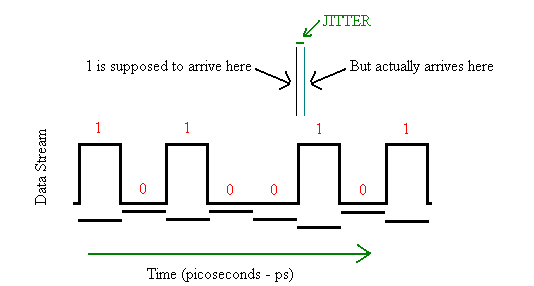An artifact called “jitter” remains a difficulty. Jitter occurs when the distance between digital information, in time, is incorrect. For  example, when an “off” bit is followed by an “on” bit, and the “off” bit is read for too long a period of time, it crowds on to the time that the “on” bit would be normally read and confuses the interpretation. Think of it again as receiving Morse Code. If the sender is inconsistent in the length of time the key is held down to make dots and dashes, you might mistake a short dash for a dot, and a long dot for a dash.
example, when an “off” bit is followed by an “on” bit, and the “off” bit is read for too long a period of time, it crowds on to the time that the “on” bit would be normally read and confuses the interpretation. Think of it again as receiving Morse Code. If the sender is inconsistent in the length of time the key is held down to make dots and dashes, you might mistake a short dash for a dot, and a long dot for a dash.
Another way of looking at jitter is when the DAC receives a 16 bit word, a command is given, converting the 16 bit word to a voltage. Jitter causes the command to be given a little too early or a little late. It results in a distortion of the waveform, making it bulge outward if the bits are received too early, and curve inward if received too late.
This is a simplification of a very complicated factor, but in any case, it is the timing of the data stream that is involved where jitter is concerned. However, there are many engineers who feel jitter is not really an audible problem and dismiss it as unimportant. Newer machines are being designed with low jitter in mind. Although the sound quality is the ultimate basis for a final decision on whether to purchase a particular CD player, you can ask for the specification on this if it is available when considering your purchase, with the lower the jitter, the better (measured in picoseconds, or trillionths of a second, that’s right, trillionths!) Jitter rates of 30 picoseconds or less are found in top quality CD players. CD players with high jitter can sound harsh and also lose fine detail, including the upper natural harmonics. One new technique is to store the digital data from the CD in a memory buffer where it can be reclocked and fed to the DAC in precise sequence. CDs can also differ in quality. Although CDs all have 16 bit words representing the audio, a poorly engineered CD might have 14 bits of music while the last 2 of the 16 bits in its audio data stream consist of noise coming from any of several sources. Also, many CDs simply do not make use of the highest voltage values, since there is a “brick wall” when the volume hits that 32,500th value. By keeping the recording level down, that brick wall is never reached.


